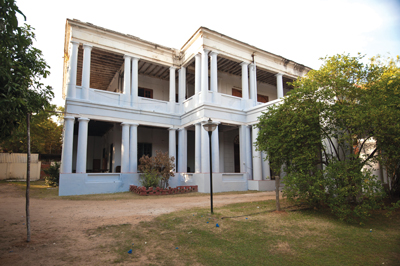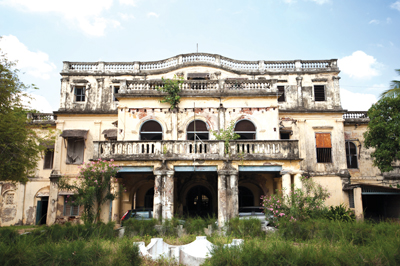
Lushington Gardens, Saidapet

Now home to the CSI Deaf and Dumb School in
San Thomé |
Deep in the concrete jungle of the city of Chennai (still Madras to many) lie several architectural gems. They are the ‘Garden Houses’, picturesquely proportioned and Palladian-style buildings put in place in the genteel and refined Georgian period of British colonial influence, as distinct from the more ponderous and pragmatic buildings of the later, more pedantic, Victorian Raj. They were built to live in, and their design reflected the taste of the times with elegant colonnades of pillars, paired or single, fronting a deep shady verandah in which the occupants could stroll or dine, with some respite from the heat of the sun. They were often flat-roofed, but sometimes with a well-balanced pediment above a graceful staircase and portico, or the latter might extend outwards from the entrance forming a shelter from sun or rain for coaches bringing visitors.
The whole resembled the 18th Century structures of London or Paris, but in miniature, or the great villas of the time in the southern United States. The columns, and the building itself, were made of brick, and rendered with a hard and shining lime plaster, mostly special to Madras, and called chunam. This was made from sea shells, and other arcane ingredients such as egg white and sugar, in formula now largely lost to history. Chunam could be polished to a smooth, marble-like appearance, with something of the same consistency, and was often painted to mimic this to perfection. The exact roundness achieved in these columns is remarkable, giving the complete appearance of a Greek Doric column. This can only be achieved by first building the column with specially constructed bricks, one face of each forming part of a circle so that an assembly of many forms the column, before applying the chunam. There was, therefore, a fortuitous synergy of the new immigrant money, arising in British hands, and the exemplary skills of the local craftsmen for whom extra employment must have thus become available.
The houses were set in extensive gardens in which amateur botanists could delight in collecting the more beautiful regional flora, but where also there were kitchen gardens in which both local and European vegetables could be grown.
An interesting description from those early times, which gives a contemporary feel for these buildings, can be found in the letters of an English family writing home in 1802. “They are all like pictures of Italian palaces with flat roofs or balustrades. I hardly know what to compare them to that you know, for they look like marble, and are all built with columns, but it is a lighter kind of building than fine churches in London, and much more beautiful architecture than the inferior ones. Lord Tilney’s house is like a great many of them with a double flight of steps outside, but many are only pavilions with nothing above the ground floor, which is the case of the house we live in.
“They are the prettiest houses, but the upstairs houses as they call them have more air. These houses are built of brick and cased over with the chunam. This is a finer lime than the plaster of Paris and it is made of the small white shells which the rough surf occasions the sea to throw up in great quantities. The stucco made of this lime, and called chunam, bears a polish almost equal to white marble but is, I think, more like the polish, or glaze, of very smooth white china. The walls, columns and balustrades are all polished. The walls of rooms are sometimes painted, as stucco rooms in England are painted of pale green-blue. Some people colour the chunam for the outside of the house of a light grey, in imitation of the grey granite of the country, leaving the columns, pilasters etc. white.
“The floors are also of this chunam, coloured according to the fancy of the owner, and here it so exactly resembles marble pavements that I should not have known. Our house has black squares, and white ones for the sitting rooms, and in the other rooms a light tint is much used. Some have dove and black squares, or all dove, which is neat. They mark it in squares so deep that it would deceive anybody. We have folding doors in all the rooms which are, half way, green-painted Venetians. The windows are all Venetians, and no glass, but we can thus exclude the light and yet have air from room to room through the whole house, but they are generally all open, and there are always as many doors as windows.”
There are still several of these houses scattered across Madras, mostly decaying, and seemingly unloved and unwanted by the majority. The notable exception is the Madras Club, a sweeping white curve of classical beauty sited in extensive grounds, a regular feature. It is sympathetically restored and loved, a beacon in a depressing array of crumbling ruin. In an attempt to find, and map the whereabouts of what is left of other such houses, we were fortunate to have the help of the Editor of this journal. Other places were found by chance, one being spotted from the top of St. Thomas’ Mount, and another at an ad-hoc visit to a school for the deaf-and-dumb. Most are derelict, although one was lived in, but the owner was uncertain how much longer he could manage to run it. The extensive garden was entirely built over with a motley array of houses, and there was overall a sad air of lost history.
Tourists do not visit Indian cities for the primary reason of shopping or dining out. They visit to mingle with, and observe, the street and bazaar life but, above all, to admire with astonishment the architecture and the history; the great Moghul palaces and tombs; the staggeringly intricate and beautiful Hindu temples, and much else besides. Part of this panoply could be the more finely designed buildings of British colonies, such as the Garden Houses of Madras, or the strikingly proportioned colonnaded buildings of Fort St. George. India has survived and absorbed numerous attempts at colonisation and risen from them with pride, but also enrichment. To smudge out events from the past is pointless and unproductive. To enhance the richly varied culture of the country by preserving these architectural gems is surely worthwhile.
|